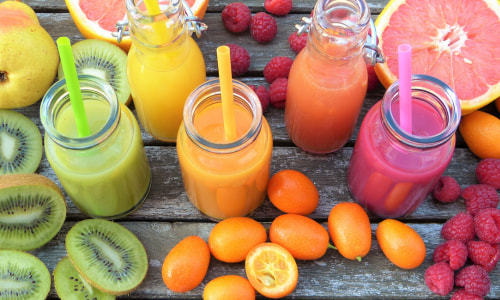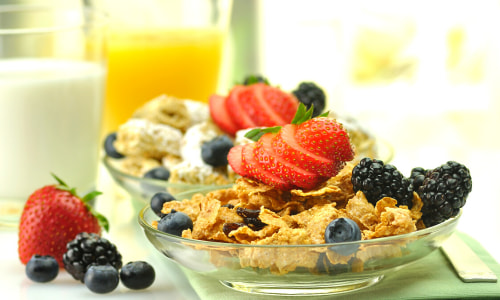8 Fruit Juices High in Fiber
“8 Fruit Juices High in Fiber” was written by Emily Reiser, RDN, LDN & edited/reviewed by Aly Bouzek, MS, RDN.
With a desire to make new types of juice and the reality that most of us don’t get in enough fiber every day, the interest in creating high fiber juices is increasing.
Continue reading to learn more about fiber and how to create high fiber juices that are as delicious as they are nutritious!
What is Fiber?
Fiber is a type of carbohydrate found in plants that our bodies can’t digest.
Rather than breaking down to provide the body with energy in the way protein, fat and carbohydrates do, fiber remains relatively intact while moving through the entirety of the digestive tract.
This process of fiber moving through the stomach, small intestine, and large intestine can help regulate the rate of digestion and provide bulk. This bulk helps improve overall bowel health and reduces chances of constipation.
Soluble Fiber vs. Insoluble Fiber
There are two types of fiber: soluble fiber and insoluble fiber.
Soluble fiber dissolves in water and forms a gel-like material. This slows digestion and can help to lower cholesterol and glucose levels.
Soluble fiber is found in:

- Oat bran
- Barley
- Nuts
- Seeds
- Beans
- Lentils
- Peas
- Apples
- Citrus fruits
- Carrots
- Psyllium, a common fiber supplement
Insoluble fiber, or “bulk,” promotes digestion and allows for quicker movement through the digestive tract. This can be helpful for people who struggle with constipation.
Foods high in insoluble fiber include:
- Wheat bran
- Whole wheat flour
- Nuts
- Beans
- Vegetables such as cauliflower, green beans, and potatoes
Benefits of Fiber
A high fiber diet can provide improvements in health, ranging from improved digestion and constipation relief, to lowered cholesterol levels and weight control.
Let’s learn a little more about the benefits of fiber!
Promotes Healthy Bowels
The bulk provided by fiber gives weight to the stool, reducing the risk of constipation by making the stool easier to pass. In addition to constipation relief, fiber may reduce the risk of hemorrhoids and diseases of the colon.
It is important to note that adequate fluid intake is essential and works with fiber to create healthy and regular bowel movements.
Promotes a Healthy Heart
Soluble fiber can help reduce total cholesterol as well as LDL or “bad” cholesterol levels. This is because soluble fiber forms a gel-like structure that slows digestion.
While the digestion is slowed, the fiber can trap fat which prevents some cholesterol from being absorbed. This leads to overall lower cholesterol levels.
Promotes Blood Sugar Control
Similar to how soluble fiber’s gel like structure slows digestion to lower cholesterol, the slowed digestion can also help with blood sugar control.
As digestion is slowed, the digestion of carbohydrates is slowed as well. This means the sugar from carbohydrate foods is brought to the blood more slowly. This helps to reduce and preventing blood sugar spikes.
Promotes Healthy Weight and Overall Health
High fiber diets are positively associated with lower weights. This is likely due to fiber’s slow digestion and bulk, allowing people to feel fuller for longer.
High fiber foods tend to be less calorie dense and have more volume, which can often lead to reduced caloric intake.
In addition, increased fiber intake of at least 25 grams per day can help lower the risk of developing diabetes, heart disease, stroke, breast cancer, and colorectal cancer.
Fiber Recommendations
According to the Institute of Medicine, the recommended fiber intake for men 50 years or younger is 38 grams per day. For men aged 51 years or older, the recommended fiber intake is 30 grams per day.
The recommended fiber intake for women aged 50 years or younger is 25 grams per day. For women aged 51 years or older, the recommended fiber intake is 21 grams per day.
Generally, the more fiber consumed, the more of a positive impact it will have on health outcomes.
Juice vs. Smoothies
There are many high fiber foods that can be consumed to increase our overall fiber intake and improve our health. These foods can be consumed in a variety of ways, including in juices and smoothies.
How Juice is Made
Generally, juice is made by removing the fiber or “bulk” from a food item. This strips the food item of its fiber, leaving behind only the liquid and additional nutrients from the food item being juiced.
Fiber: Smoothies vs. Juices
Juice is stripped of its bulk (fiber) and is generally very low in fiber.
Smoothies, on the other hand, blend the fiber from the ingredients into the drink rather than removing the fiber or bulk. This allows for a similar drink that is a bit thicker and much higher in fiber depending on the ingredients added.
Don’t miss this delicious Chocolate Peanut Butter High Fiber Smoothie!
Fruit Juices High in Fiber
Though fiber is striped in the juicing process, there are some fruits and vegetables that maintain a higher fiber content even after being juiced. Some of these juices include prune juice, orange juice with pulp, grapefruit juice, and papaya juice!
See below for fiber amounts.
8 Highest Fiber Fruit Juices:
| Highest Fiber Fruit Juices | Serving Size | Fiber (grams) |
| Prune juice, 100% | 1 cup | 2.5 |
| Grapefruit juice, 100% | 1 cup | 1.5 |
| Papaya juice, 100% | 1 cup | 1.5 |
| Apple juice, 100% | 1 cup | 0.5 |
| Grape juice, 100% | 1 cup | 0.5 |
| Orange juice, 100% | 1 cup | 0.5 (w/ pulp, adds just a little more fiber) |
| Pomegranate juice, 100% | 1 cup | 0.3 |
| Cranberry juice, 100% | 1 cup | 0.3 |
Though through the initial process of creating juice, much of the fiber is stripped, there are ways to add fiber back in to create a higher fiber juice option. Check out our tips below!
Adding Fiber to Fruit Juice
During the process of juicing, the fiber of the fruit or vegetable is removed to leave behind only the water and nutrients.
However, there are ways to add the fiber (bulk) back into your juice. This is commonly seen when pulp is added to/left in orange juice.
Add High Fiber Foods
In addition to bulk or pulp being added back to juice, other ingredients can be added to juices to increase their fiber content.
These ingredients include:
- Flaxseed meal
- Chia seeds
- Raspberries
- Blackberries
- Fiber supplement powders such as psyllium husk or inulin
- Blend in high fiber vegetables (carrots, kale, beets, etc.)
Pair Juice with High Fiber Foods

Though juices are typically lower in fiber, a snack or meal can still have a good amount of fiber if the juice is paired with a high fiber food.
This snack or meal could include high fiber foods such as oats, wheat bran, nuts, seeds, beans, fruits, or vegetables to name a few.
Pairing something such as orange juice with a wheat bran cereal with reduced fat milk and topped with nuts and berries will provide a significant amount of fiber to start the day without having to “remake” the orange juice being served.
Conclusion
Fruit juice tends to be lower in fiber overall. Choosing fruit and vegetable juices that are higher in fiber, even after being juiced, is a great base for creating fruit juices high in fiber.
Additionally, adding extra high fiber ingredients will help to increase the overall fiber content of the drink.
In general, smoothies are higher in fiber as the bulk of the fiber remains after being blended, rather than being stripped during the process of juicing.
If you prefer lower fiber juice ingredients, then pairing the juice with a high fiber snack would be a great alternative to meet your fiber needs. For more information on high fiber drinks, visit: High Fiber Drinks to Get More Fiber.
